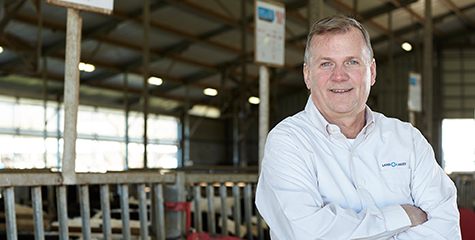
How to Mix Calf Milk Replacer
Calf : Feeding Tools
Animal : Calf
“Dairy calves love consistency,” said Dr. Tom Earleywine, director of nutritional services with Land O’Lakes Animal Milk Solutions. “If we’re going to do a good job of feeding our calves, we have to make sure the diet is very, very consistent.”
Ensure you’re delivering consistent nutrition to your dairy calves with accurate weighing and mixing of calf milk replacer at every feeding. Watch this video for more tips on bulk mixing as well as pail and bottle feeding with Dr. Earleywine.
Mix while adding the remaining water to reach the total volume of solution to feed all calves. Inspect carefully to assure that all calf milk powder is thoroughly mixed and there are no lumps.
Feed a full potential milk diet at a rate of 2.5 pounds of milk solids in 8-12 quarts of milk or calf milk replacer per day. The milk diet can be delivered 2x/day, 3x/day or with an automatic calf feeder.
Stick to equally spaced, established feeding times.
For bottle feeding, nipples should be replaced when they show any significant signs of wear to avoid bacterial build up. Check the valve and opening size so calf milk replacer only drips when the bottle is inverted.
Test the temperature of milk fed to the first calf, a middle calf and the last calf fed.
Ensure you’re delivering consistent nutrition to your dairy calves with accurate weighing and mixing of calf milk replacer at every feeding. Watch this video for more tips on bulk mixing as well as pail and bottle feeding with Dr. Earleywine.
Step 1: Weighing Calf Milk Replacer
Weighing calf milk replacer powder, rather than using cups or scoops, will always be the most accurate and consistent feeding method. Use a calibrated scale to weigh the powder.Step 2: Mixing Calf Milk Powder
Mix powder into water that is 110-120 degrees F. Batch mixing is recommended. Fill the mixing container with half of the total volume of water needed, then pour the powder on top of the water.Mix while adding the remaining water to reach the total volume of solution to feed all calves. Inspect carefully to assure that all calf milk powder is thoroughly mixed and there are no lumps.
Step 3: Serving Size
The amount of calf milk replacer fed at each meal depends on the number of times a day you feed.Feed a full potential milk diet at a rate of 2.5 pounds of milk solids in 8-12 quarts of milk or calf milk replacer per day. The milk diet can be delivered 2x/day, 3x/day or with an automatic calf feeder.
Stick to equally spaced, established feeding times.
Step 4: Method of Feeding Calves
When feeding with buckets, use a flow meter or mark the correct volume on buckets to consistently deliver the same amount of milk at every feeding.For bottle feeding, nipples should be replaced when they show any significant signs of wear to avoid bacterial build up. Check the valve and opening size so calf milk replacer only drips when the bottle is inverted.
Step 5: Feeding Temperature
Feeding temperature should be 101° to 105°F. Use a thermometer to guarantee the correct temperature.Test the temperature of milk fed to the first calf, a middle calf and the last calf fed.





